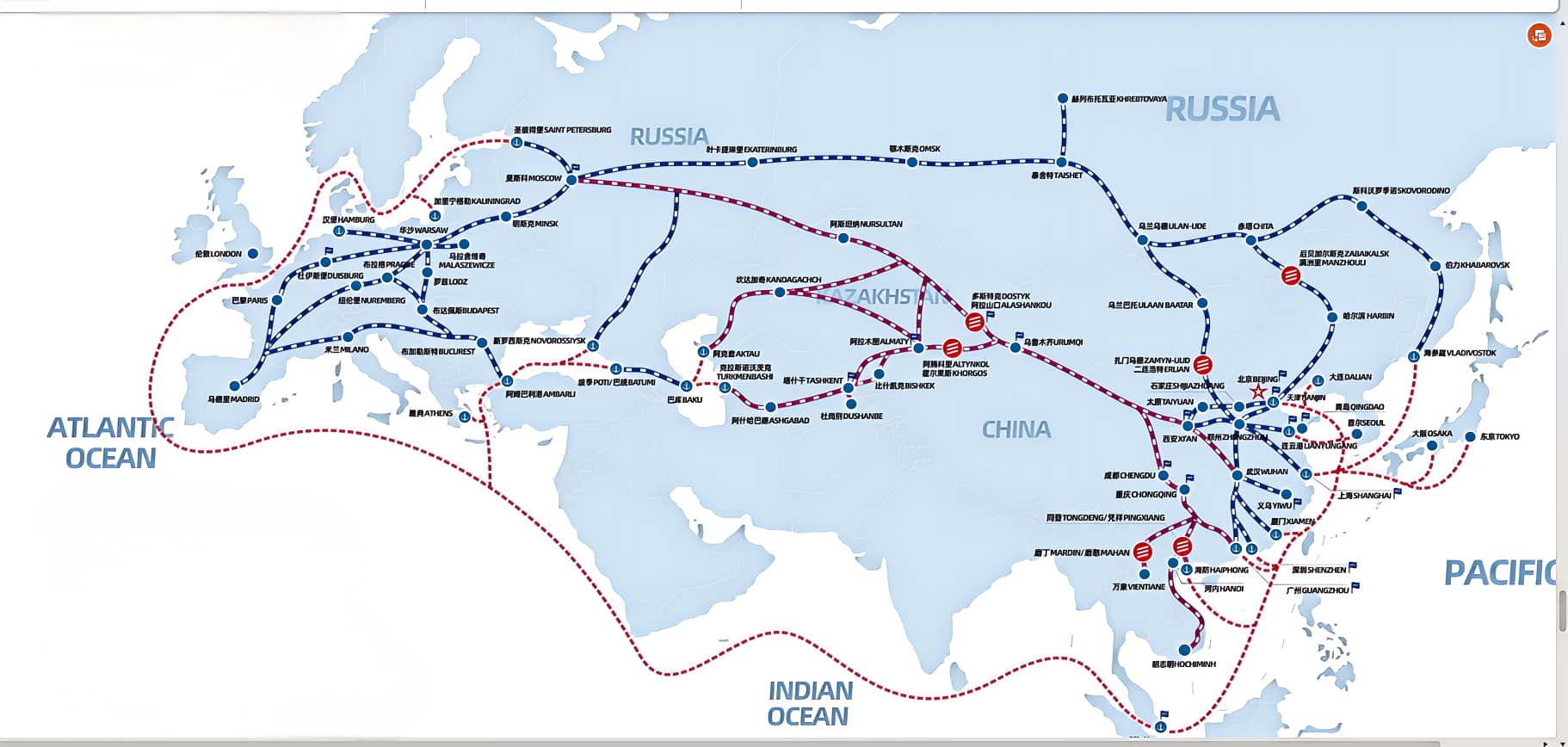China-Europe Freight Train: Common Questions and Answers

1. Is the China-Europe Freight Train a Chinese Train Running All the Way to Europe?
Not exactly. Chinese trains only run to the China-Kazakhstan border. Strictly speaking, the trains extend a short distance into Kazakhstan, where the containers are transferred to another train operated by Kazakhstan. Then the Chinese train returns to its original route.
Due to the difference in track gauges between China's standard gauge and the wide gauge used by CIS countries, the track gauge needs to be changed at the China-Kazakhstan border. Within the CIS countries, locomotives and drivers are also changed as needed, switching to local locomotives and personnel. The CIS wide-gauge railway ends at the EU border, requiring another transfer to EU-standard locomotives.
Therefore, the trains that arrive in Europe are all European trains.
If standard gauge were implemented all the way to Europe, and Chinese trains could technically run to Europe, numerous challenges would arise. For example, how many drivers would be required for the journey? How many languages would the drivers need to know? They would need to interpret and follow various signals and instructions. Currently, a Polish driver can drive into Germany, but they need a special license for specific routes. A new license is required for a different route.
This highlights the complexity and coordination required in modern rail freight services, particularly when spanning multiple countries with differing rail gauges, operational standards, and legal frameworks. The China-Europe rail route showcases how international cooperation is essential in rail logistics.
Despite the challenges, rail continues to be a reliable and cost-efficient mode of freight transport between Asia and Europe, striking a balance between speed and affordability compared to air and sea freight.
2. Why Does the Average Speed of the China-Europe Freight Train Fall Below 30 km/h?
In theory, with current high-speed train technology (300 km/h), the 10,000 km journey would take only a day and a half. However, the key is the word "average."
For most of the route, the trains travel at speeds exceeding 100 km/h. However, they must stop at several points, such as Alashankou and Malaszewicze, for tasks like changing track gauges, customs clearance, and replacing railway waybills. If the total journey takes 16 days, 4-5 days are spent stationary, leaving only 11–12 days of actual travel. Averaged over the entire journey, the speed drops to below 30 km/h.
3. How Long Are the China-Europe Freight Trains? Do Standards Differ Across Countries?
Russia operates the longest trains, up to 1,500 meters, capable of carrying 75 forty-foot containers. The shortest trains are in Germany, only 650 meters long, which can carry 41 forty-foot containers—the standard length for most China-Europe freight trains.
Germany often faces criticism for its "short" trains. Many German rail yards have tracks no longer than 650 meters. Operating costs for trains of different lengths are nearly the same, so longer trains are more efficient, transporting more goods with similar power requirements.
In contrast, the U.S. uses double-stack containers for greater efficiency. Other European countries, such as the Netherlands, are trying to improve efficiency by adopting 750-meter trains. However, infrastructure upgrades are needed to accommodate longer trains, and progress is slow due to governmental inefficiency. Without such changes, 750-meter trains cannot be fully utilized.
To maximize efficiency and reduce costs, logistics teams often use a shipping container loading calculator when preparing cargo for China-Europe freight trains. These tools help visualize and plan how to load goods into 20-foot or 40-foot containers, minimizing unused space and ensuring the cargo is stable and compliant with weight limits. For companies shipping large volumes or irregularly shaped goods, a 3D container loading calculator can significantly reduce freight costs and avoid load imbalances that may cause damage or delays during rail transit. Integrating these tools into logistics planning supports smoother, more predictable delivery schedules.
For businesses that don't have enough cargo to fill an entire container, less than container load shipping rates (LCL) present a flexible and cost-effective alternative. LCL allows multiple shippers to share space in a single container, each paying only for the volume they use. While this method is more common in sea freight, some rail routes now offer LCL services to meet the demand for affordable, small-volume shipping between China and Europe.
4. Do China-Europe Freight Trains Only Use the Blue Containers from China Railway?
On June 8, 2016, China Railway officially launched the unified China-Europe Freight Train brand. Trains departed from Chongqing, Chengdu, Wuhan, Zhengzhou, Suzhou, and Yiwu under this unified brand, which features a logo incorporating elements like a speeding train and a fluttering silk ribbon.
The blue containers are just one part of the available container supply. Other containers are provided by companies like Maersk, COSCO Shipping, and other major railway companies.
5. Can China-Europe Freight Trains Transport Refrigerated Containers, Hazardous Goods, or Express Parcels?
Some refrigerated containers are provided by Unite 45, a Dutch company, but their use remains unstable. These containers require special diesel fuel for cooling, and refueling along the route is unreliable. Each container's temperature must be manually set, requiring significant time and effort.
Currently, hazardous goods like car airbags and lithium batteries cannot be transported on China-Europe trains. Liquid goods can be transported on certain routes. In China, hazardous goods are primarily transported by truck, while in Europe, the opposite is true.
Reforms are underway in China to allow hazardous goods transport by rail, which would require new safety technologies and packaging solutions. Once approved, the growing electric vehicle market could benefit significantly.
China-Europe freight trains cannot transport express parcels as they primarily serve businesses (B2B). Parcel transport involves complex regulatory issues across multiple countries, which makes it unfeasible at present.
6. Why Do Most China-Europe Freight Trains Exit Through Alashankou Instead of Manzhouli?
The main factor is geography. Alashankou offers the shortest exit route, while the northern route through Manzhouli is about 2,000 km longer.
When evaluating total logistics costs, companies must look beyond just rail or sea transit rates. Additional costs—such as destination charges sea freight—can significantly impact the final expense. These fees may include terminal handling, customs clearance, port security, documentation, and delivery charges once the container reaches the destination port. Even if the bulk of the journey is by rail, hybrid shipping routes that involve sea freight legs (such as China to Russia by rail, then by sea to final European destinations) will still incur these charges.
Why Should You Work with a Freight Forwarder in China for rail cargo?
Given the intricacies of international rail and multimodal logistics, especially on routes like the China-Europe freight train, many businesses find it essential to partner with a reliable freight forwarder in China—such as CargoesPi. We manage everything from booking and scheduling to customs paperwork, cargo insurance, and real-time tracking. We also oversee critical transitions at borders, ensuring compliance with varying national regulations and seamless handovers
About CargoesPi
CargoesPi is a China-based freight forwarder offering reliable rail, sea freight, and air freight logistics solutions—specializing in China-Europe freight train services and end-to-end cargo coordination, with a strong focus on serving clients across North America and Europe.

